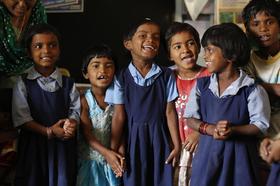Serving 663 students in grades Kindergarten-5, Fox Chase Elementary School ranks in the top 50% of all schools in Illinois for overall test scores (math proficiency is top 50%, and reading proficiency is top 50%).
The percentage of students achieving proficiency in math is 28% (which is higher than the Illinois state average of 27%). The percentage of students achieving proficiency in reading/language arts is 32% (which is higher than the Illinois state average of 30%).
The student-teacher ratio of 17:1 is higher than the Illinois state level of 13:1.
Minority enrollment is 54% of the student body (majority Hispanic), which is lower than the Illinois state average of 55% (majority Hispanic).
Quick Facts (2025-26)
- Grades: Kindergarten-5
- Enrollment: 663 students
- Student-Teacher Ratio: 17:1
- Minority Enrollment: 54%
- Overall Testing Rank: Top 50% in IL
- Math Proficiency: 28% (Top 50%)
- Reading Proficiency: 32% (Top 50%)
- Science Proficiency: 65-69% (Top 20%)
- Source: National Center for Education Statistics (NCES), IL Dept. of Education
Top Rankings
Fox Chase Elementary School ranks among the top 20% of public schools in Illinois for:
Category
Attribute
Science Proficiency
Diversity
School Overview
Fox Chase Elementary School's student population of 663 students has grown by 14% over five school years.
The teacher population of 38 teachers has grown by 8% over five school years.
Grades Offered
Grades Kindergarten-5
Total Students
663 students
Gender %
Total Classroom Teachers
38 teachers
School Rankings
Fox Chase Elementary School ranks within the top 50% of all 3,542 schools in Illinois (based off of combined math and reading proficiency testing data).
The diversity score of Fox Chase Elementary School is 0.67, which is less than the diversity score at state average of 0.69. The school's diversity has stayed relatively flat over five school years.
Overall Testing Rank
#1243 out of 3542 schools
(Top 50%)
(Top 50%)
Math Test Scores (% Proficient)
28%
27%
Reading/Language Arts Test Scores (% Proficient)
32%
30%
Science Test Scores (% Proficient)
65-69%
50%
Student-Teacher Ratio
17:1
13:1
American Indian
n/a
n/a
Asian
4%
6%
Hispanic
33%
28%
Black
12%
17%
White
46%
45%
Hawaiian
n/a
n/a
Two or more races
5%
4%
All Ethnic Groups
Eligible for Free Lunch
19%
43%
Eligible for Reduced Lunch
2%
4%
School Statewide Testing
School District Name
Source: National Center for Education Statistics (NCES), IL Dept. of Education
Profile last updated: 02/09/2025
Frequently Asked Questions
What is Fox Chase Elementary School's ranking?
Fox Chase Elementary School is ranked #1243 out of 3,542 schools, which ranks it among the top 50% of public schools in Illinois.
What percent of students have achieved state testing proficiency in math and reading?
28% of students have achieved math proficiency (compared to the 27% IL state average), while 32% of students have achieved reading proficiency (compared to the 30% IL state average).
How many students attend Fox Chase Elementary School?
663 students attend Fox Chase Elementary School.
What is the racial composition of the student body?
46% of Fox Chase Elementary School students are White, 33% of students are Hispanic, 12% of students are Black, 5% of students are Two or more races, and 4% of students are Asian.
What is the student-teacher ratio of Fox Chase Elementary School?
Fox Chase Elementary School has a student ration of 17:1, which is higher than the Illinois state average of 13:1.
What grades does Fox Chase Elementary School offer ?
Fox Chase Elementary School offers enrollment in grades Kindergarten-5
What school district is Fox Chase Elementary School part of?
Fox Chase Elementary School is part of Community Unit School District 308.
School Reviews
Review Fox Chase Elementary School. Reviews should be a few sentences in length. Please include any comments on:
- Quality of academic programs, teachers, and facilities
- Availability of music, art, sports and other extracurricular activities
Recent Articles

How to Pick the Right Public School for Next Semester
A clear, step-by-step guide to choosing the right public school for next semester, including timelines, comparisons, and expert insights.

Hidden Costs of Private School: Fees, Uniforms, Transport and More
Understand the hidden costs of private school in 2025, including uniforms, fees, meals, activities, transport, and technology.

Private vs. Public School: Reality Check- 2025
A 2025 update on private vs. public schools—tuition, enrollment trends, policy shifts, and what parents should consider in today’s landscape.









